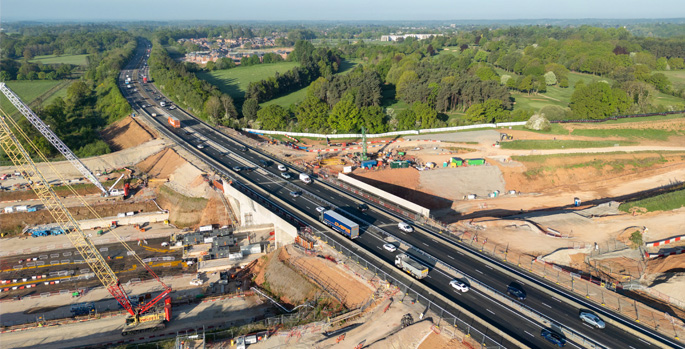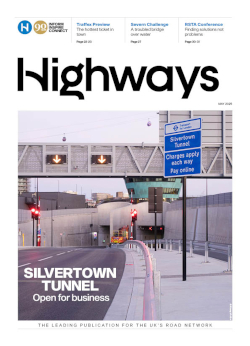The A46 Kenilworth Bypass was reopened to traffic 30 hours ahead of schedule after Balfour Beatty VINCI closed the road from 11 April – 29 April to allow its engineers to slide a 14,500-tonne concrete box structure into position beneath the road for High Speed 2 (HS2).
The box is the largest of its kind in Europe and forms one of 200 new viaducts and bridges that will allow for high-speed trains to travel from London to Birmingham on the new line. This new addition to the A46 will allow the trains to pass under the dual carriageway on its approach to the New Interchange station.
The designers of HS2 chose a box structure that could be built alongside the road and slid into place in one operation so they could avoid speed restrictions and lane closures that would have lasted for two years in order to build a ‘more traditional bridge design’.
The initial stage of the project involved the demolition of a 200 metre section of the old road and the excavation of around 35,000 cubic metres of material to make space for the box to be pushed into place.
The second stage involved pushing the 42 metre wide structure into position, which took over 10 hours. Specialist engineers used a jacking mechanism called Autoripage, designed by Freyssinet, to push the box across on a guiding raft at an average speed of 6.5 metres per hour for a total distance of 64 metres. Fifteen jacks were then used to guide the box into position.
A series of holes in the base of the box allowed for the injection of bentonite – a clay-based material – into the space between the box and the ground, which acted a lubrication to help ease the sliding operation.
Finally, the embankment which carries the road was reconstructed, with a new carriageway put into place, allowing the road to be reopened to traffic at around midnight on the 29 April – 30 hours ahead of schedule.
John McNiffe, project director at Balfour Beatty VINCI, project team leader said: ‘We’re extremely proud to have successfully delivered the UK’s heaviest bridge slide across the A46 in Warwickshire. It’s a huge achievement for the dedicated project team who’ve worked tirelessly over the last two years to reach this point.
‘My team has worked around the clock, using innovative construction methods to move this bridge into place and return the road back to normal in just 18 days, reducing the impact on road users significantly.’
Cameron Thompson, HS2 Ltd’s head of delivery also said: ‘This record-breaking slide could not have been achieved without the years of meticulous planning and preparation that the team put in, working closely with our supply chain and National Highways. ‘While the vast majority of the bridge is now complete, we’ve still got a few weeks’ of lane closures to finish the central reservation and wingwalls – and I’d like to thank drivers in advance for their patience during these works.’
Victoria Lazenby, National Highways regional director, said: ‘Our concern with any scheme is to minimise the impact for people using or living near our roads and certainly such a huge, complex engineering feat as this would inevitably bring some disruption.
‘So to have avoided two years of lane closures and speed restrictions on one of our key routes is tremendous news. After many years working closely with HS2 and their supply chain we are delighted to see all of that planning and preparation come to fruition.
‘We are grateful to people for their patience during the road closure to enable this innovative work to take place.’
To allow time for the completion of the central reservation and wingwalls on either side, one lane on either side of the road will be closed until Thursday 31 July 2025.






